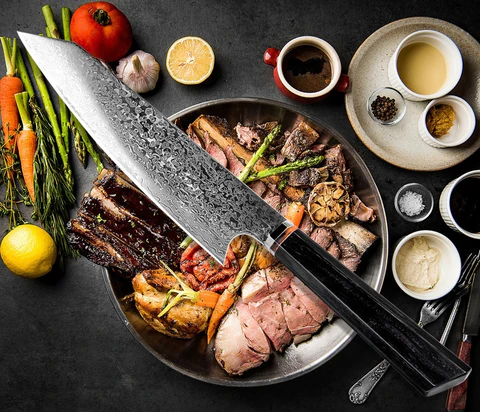If you're passionate about cooking or work as a chef, chances are you've heard of the "kiritsuke" knife. This Japanese culinary tool has gained widespread recognition for its versatility and distinct design. In this post, we'll delve deeper into what makes the kiritsuke knife so beloved by chefs across the globe. We’ll explore its history, practical applications, and essential maintenance tips. By the end of this article, you'll understand why having one in your kitchen could significantly enhance your cooking experience.

### What Exactly Is a Kiritsuke Knife?
The kiritsuke knife is essentially a hybrid of two traditional Japanese knives: the yanagiba and the usuba. Known for its unique shape, the kiritsuke features a long, flat edge that gently curves toward a pointed tip. This design allows for both precise slicing and adaptability in various cooking tasks. Measuring between eight and twelve inches in length, it’s ideal for cutting fish, chopping vegetables, or even performing delicate tasks like julienning. One of its standout features is its single-bevel edge, which provides an exceptionally sharp blade that's particularly easy to control—especially for right-handed users.
The kiritsuke knife symbolizes craftsmanship and skill in Japanese cuisine. Typically, only the head chef in a Japanese restaurant is entrusted with handling this blade, signifying their advanced expertise and years of practice. This exclusivity adds a layer of intrigue for those who haven't had the chance to work with one directly.
### A Brief History of the Kiritsuke Knife
The origins of the kiritsuke knife are deeply rooted in Japanese culinary traditions. It emerged due to the need for a versatile tool capable of performing multiple tasks with precision. Over time, meticulous Japanese blacksmiths and professional chefs refined its design, ensuring it remained both functional and aesthetically pleasing.
Traditionally, the kiritsuke was primarily used for preparing sushi and sashimi, where exact cuts are crucial. Its slender, long blade excels at slicing fish into thin, uniform slices. As Japanese cuisine grew in popularity worldwide, so did the demand for this knife, spreading its reputation far beyond Japan.
While the basic design hasn’t changed much over the years, modern versions incorporate advanced materials that ensure durability and ease of cleaning without compromising its classic charm.
### Versatility in Action: What Can You Do With a Kiritsuke Knife?
The kiritsuke knife is a true jack-of-all-trades in the kitchen. Here are some of its key uses and advantages:
- **Fish Slicing:** The kiritsuke’s long blade makes it perfect for slicing fish into delicate, even pieces. It’s a staple in sushi and sashimi preparation.
- **Vegetable Preparation:** Thanks to its flat edge, you can chop or julienne vegetables with precision. The slight curve near the tip also allows for rock chopping, making it versatile for different cutting styles.
- **Multi-Purpose Use:** Unlike some knives that excel in only one task, the kiritsuke is adaptable enough to handle a variety of kitchen chores, reducing the need for multiple tools.
- **Aesthetic Appeal:** Beyond functionality, these knives are often works of art, featuring intricate designs and crafted from high-quality materials. They’re not just tools; they’re conversation starters in any kitchen.
Mastering the use of a kiritsuke knife requires practice and skill, especially due to its single-bevel edge. However, once you’ve got the hang of it, it becomes an indispensable part of your culinary arsenal, making cooking easier and more enjoyable.
### Caring for Your Kiritsuke Knife
To keep your kiritsuke knife sharp and in pristine condition, follow these essential care tips:
- **Regular Sharpening:** Use a whetstone to sharpen the knife frequently. Maintaining the single-bevel edge requires careful attention.
- **Proper Cleaning:** Clean the knife with warm water and mild soap immediately after each use. Avoid harsh materials that could scratch or damage the blade.
- **Safe Storage:** Store your knife in a knife block or on a magnetic strip to protect the blade from scratches. Avoid storing it loose in drawers.
- **Soft Cutting Surfaces:** Always use wooden or plastic cutting boards. Hard surfaces like glass or marble can quickly dull the blade.
By adhering to these guidelines, your kiritsuke knife will remain in excellent condition for years, maintaining its sharpness and beauty.
### Choosing the Right Kiritsuke Knife for You
Selecting the perfect kiritsuke knife involves considering several factors. Here's what to keep in mind:
- **Blade Material:** Carbon steel offers exceptional sharpness but requires more maintenance compared to stainless steel, which is less sharp but easier to care for.
- **Handle Design:** Opt for handles that feel comfortable in your hand. Traditional wooden handles are elegant and ergonomic, while modern composite handles are water-resistant and durable.
- **Size and Weight:** Choose a length that suits your comfort and intended use. Longer blades (10-12 inches) are ideal for slicing large pieces of fish or meat, while shorter ones (8-9 inches) are versatile all-purpose knives.
- **Edge Type:** Traditional kiritsuke knives have single-bevel edges, which are sharper but harder to use or sharpen if unfamiliar with this style. Modern versions often feature double-bevel edges, making them easier to handle.
- **Budget:** Kiritsuke knives vary in price. Set a budget and find a quality option within that range. Generally, investing more often leads to better performance and longevity.
### Conclusion
The kiritsuke knife is more than just a kitchen tool—it’s a testament to Japanese culinary artistry, combining precision, versatility, and tradition. Whether you’re a professional chef or an enthusiastic home cook, adding a kiritsuke knife to your collection can elevate your cooking experience. Its unique design and functionality make it an invaluable asset in any kitchen.
Ready to upgrade your culinary arsenal? Explore the elegance and efficiency of the SAKUTO Japanese Damascus Steel Kitchen Knife With Coloured Octagonal Handle. Discover the difference a high-quality kiritsuke knife can make in your kitchen today!
Red Pepper,Red Pepper Dry Pepper,Especially Fresh Flavor Red Pepper,Fresh Flavor Red Pepper
Sichuan Liuhang Agriculture Co.Ltd , https://www.lhagriculture.com